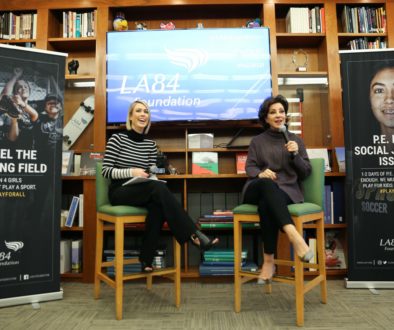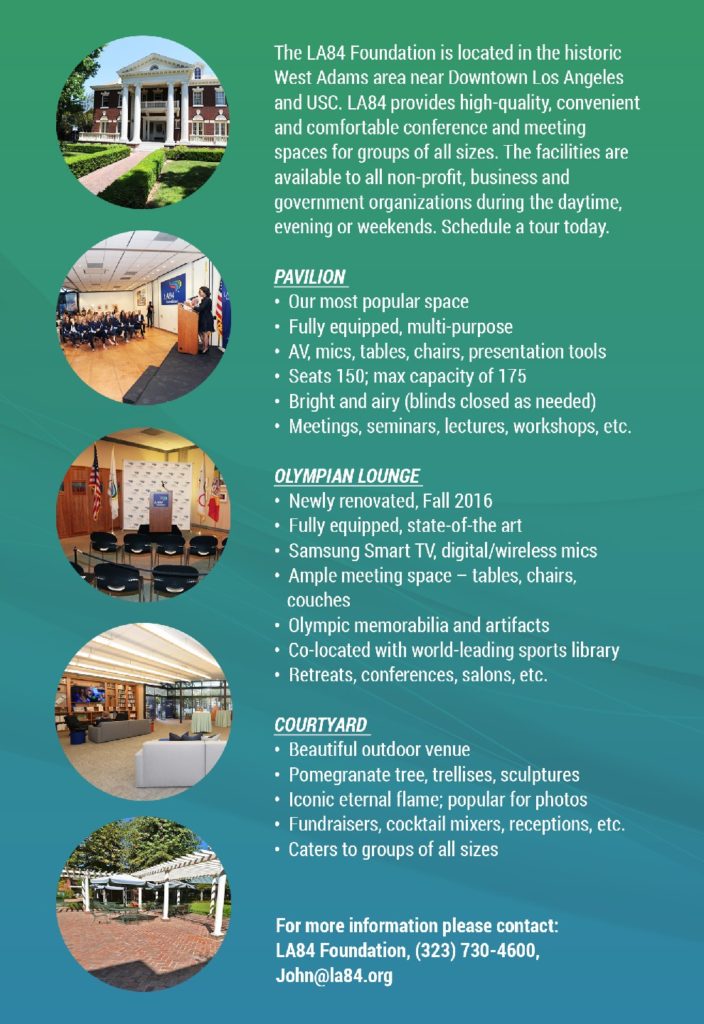SL Interview: Tamara Christopherson, Director of “Personal Gold”
Tamara Christopherson and her husband, Sky, both enjoyed remarkable successes as elite athletes. A native of Seattle, Washington, Tamara competed in women’s kayak doubles (500 meters) at the 2000 Sydney Olympic Games. Sky was named as an alternate on the 1996 and 2000 U.S. Olympic teams in track cycling. (He proposed to her after the Closing Ceremony at Sydney.)
 In 2012, as the London Olympic Games approached, the couple was dismayed to discover that USA Cycling had virtually abandoned the four women who comprised the team pursuit team – Dotsie Bausch, Sarah Hammer, Jennie Reed, and Lauren Tamayo – amidst the doping scandals that had engulfed road cycling (including, most prominently, Lance Armstrong). Unlike the opposing teams from Great Britain and Australia, the American quartet was left to prepare without corporate sponsors or fulltime staff. The team, which had finished fifth at the world championships, was forced to enlist their husbands in the cause to bolster their training efforts.
In 2012, as the London Olympic Games approached, the couple was dismayed to discover that USA Cycling had virtually abandoned the four women who comprised the team pursuit team – Dotsie Bausch, Sarah Hammer, Jennie Reed, and Lauren Tamayo – amidst the doping scandals that had engulfed road cycling (including, most prominently, Lance Armstrong). Unlike the opposing teams from Great Britain and Australia, the American quartet was left to prepare without corporate sponsors or fulltime staff. The team, which had finished fifth at the world championships, was forced to enlist their husbands in the cause to bolster their training efforts.
The couple decided to fly to Europe to assist the beleaguered women just three months before the Games. Embedded with the team, and wedded to a philosophy of “Data Not Drugs,” they filmed every training session and every wrinkle of the women’s progress. After the team’s success in London (spoiler alert: they won the silver medal behind Great Britain), they turned their unprecedented access during this unlikeliest of journeys into a feature documentary titled “Personal Gold: An Underdog Story.”
They themselves were unlikely first-time filmmakers. But inspired by the uplifting documentary films directed by the late Bud Greenspan, they decided to take on the challenge. They shaped thousands of hours of training footage into an intimate movie that captures the agonizing heartbreak and triumphant perseverance of the many Olympic athletes who compete outside of the media spotlight and have to rely on friends and family for crucial support.
SportsLetter recently spoke by phone with Tamara Christopherson about her own personal journey to make “Personal Gold.”
–David Davis
SportsLetter: Your sports background is in rowing and kayaking. How is that similar and/or different from what you discovered in velodrome cycling?
Tamara Christopherson: I’d say that all Olympic sports are more similar than they are different in that they attract a certain kind of personality and mindset. They attract a person who has this faith that they will do something that might happen four years down the road. Then there’s the people who do what I call the “straight-line” sports – like swimming and cycling and canoe/kayaking and rowing – where we are in a drag race from A to B. We’re really similar creatures.
SL: What was the situation that you discovered with the American cyclists who were training for the team pursuit in London?
TC: People who don’t follow the Olympics closely think that most athletes are like Michael Phelps, with huge endorsements and big-time financial support. The reality is, most of these athletes are living under the poverty level and live like that for years and years without any real professional prospects. They’re real purists. And, that’s what I found in these women cyclists. That was refreshing, especially within the context of what was happening in cycling at the time. Remember, this was 2011-2012, when we were at the tipping point of men’s professional road cycling, with Lance Armstrong and those [doping] scandals. It was amazing to see cycling with fresh eyes.
SL: The backdrop to this film concerns the funding, or lack thereof, in track cycling in the United States. Why did USA Cycling ignore the velodrome-based cyclists for years and concentrate on supporting road cycling and professional riders like Lance Armstrong?
TC: That was the mandate of Steve Johnson, the CEO of USA Cycling. He was running the national governing body during a time that was the peak of the popularity of road cycling, despite many people knowing rightfully that it was a smokescreen [for rampant doping]. He really believed that this would be the way that the NGB would function best financially. But he did a disservice to the Olympic Movement by cutting the funding for the Olympic medal sports, including track cycling.
Look, there’s not a sport in the family of 40-some Olympic sports that hasn’t at some point seen themselves as neglected or underrepresented in the Olympic Movement. Every sport feels this way at some point. What happened with cycling was that USA Cycling made underdogs out of the Olympic parts of the program – and women’s track cycling was in that group. It was also a new event. It was unproven. So, it was just potential.
The team pursuit program was traditionally thought of as the gauge of health for USA Cycling. And so, once they cut that program, you really had no barometer for how the program as a whole was doing. Fast forward six or seven years later: You saw the house of cards that they built. They were in a tough spot to find sponsors who were going to trust them again.
SL: You point out in the film that the individual pursuit event was cut from the Olympic program. Why did the IOC do that?
TC: In 2009, the individual pursuit was taken out of the Olympic program. In its place was another individual event called the omnium [a decathlon of cycling events introduced at the 2012 London Olympics]. So, the individual pursuit – the main event of Sarah Hammer [one of the three major characters in the film] and Taylor Phinney – was replaced.
Also at play was gender equity within the Olympics. All of the international sports federations had to get to a point where 50 percent of the available medals at the Olympic Games were for women’s events. That was a huge step forward. So, cycling did the right thing: they put in a women’s team event – the team pursuit – as well as the individual event in the omnium.
SL: How did you and Sky get involved in the training of the women’s team pursuit leading up to the 2012 Olympic Games?
TC: Sky had become really involved in the Quantified Self movement. The idea behind the Quantified Self movement is this marriage of technology and data and fitness and health. In other words, we have the technology now where we can record every second of our lives if we want to and, specifically, every second we spend in training. So, it was with that framework that we thought, “Hey, let’s video everything we can, and who knows what’s going to happen?”
Truthfully, we were just there to support the women. That’s what you see in the film. We were doing most of the video work so they could get technical feedback. We recorded every single training session while we were in Spain. We would then upload it to Adam Laurent, who is a former Olympian in team pursuit. He would download this at his home in California and do a voice-over on all the technical aspects of the training session. He basically coached them because they didn’t have a technical coach. He would then upload that voice recording to the server, we would download it and then we’d email it to the women before the next session. It was kind of a crazy 24-hour operation we had going, but it got the job done.
That’s why we had so much great footage. We were really there to provide visual and technical feedback – all the things they were missing because USA Cycling had cut it from the budget when they finished fifth at worlds. USA Cycling just thought, “We’re going to write them off. We’re not going to give them the things that their coaches [Neal Henderson and Ben Sharp] had requested for the budget.” Essentially, we were filling in this missing piece that they desperately needed.
The filming was also beneficial for the athletes. Dotsie [Bausch] told us that one of the cool side effects about being on camera for those three months was that it made her better. It made her bring a little extra to training every day because she knew it was going to be recorded. That was interesting – this idea that the things you do matter to a larger audience and therefore inspire you to keep going.
SL: You and Sky worked with Dr. Eric Topol in shaping the training approach. What is his philosophy concerning data and health?
TC: Dr. Topol helped us see that data is empowering and that with individualized self-tracking we can use data to increase self-knowledge. We were inspired by him because we always believed that there was a lot of folklore and voodoo surrounding athletics and training. You do so many workouts that are, like, guesswork workouts, where you just put your faith in something and hope it kind of works out for the race or the competition.
Dr. Topol was very helpful in guiding some of the approaches that we took in terms of data collection and analysis with the athletes. This is all pretty new, and it’s pretty risky for an athlete to just buy in. I’m not sure if I would’ve opted in three months before the Olympic Games when I competed. It speaks to how much the athletes trusted Sky and trusted Jennie, because Jennie and Sky pitched this idea to the whole team. They said, “Look, we’re five seconds down. Let’s try to fine-tune everything we can and let’s do it in a way we can visualize” – and that’s through the data collection.
SL: There was a lot of data-crunching concerning everything from the athletes’ sleep patterns to their blood glucose levels. Was there one piece of data that was most significant or was it more of a cumulative thing?
TC: That’s an interesting point: where do you start when you weigh all the different aspects of the data? What athletes always hear from coaches is, start with the things that you have control over. And, the two things athletes have the most control over is their sleep and their diet. Those are the two biggest leverage points.
That’s why we started with the blood bio-markers with Sarah. I mean, who would have thought that with training outdoors and training in a velodrome with windows all around we would discover that she was severely vitamin D deficient? Vitamin D deficiency is linked to some of the challenges she was having: insomnia and other stress-related symptoms. So, learning, seeing and then being able to intervene with enough time to raise her levels of vitamin D was huge. Is it the one thing that made a difference? Definitely not. But it’s among the things that helped improve her training.
SL: Sleep has become such an important issue in training. Is it possible to improve an athlete’s sleep habits?
TC: We worked with a sleep scientist and found that measuring Jennie’s sleep patterns was a huge eye-opening experience. She was a sprinter, and so she needed more recovery time, but she didn’t know how little sleep she was actually getting. Once she was able to visualize that with the data, she could intervene and figure out how to change that for the better. She was having a lot of waking points during the night, so we recorded the ambient noise in her room for about a week to figure out what was interrupting her deep sleep. It turned out that [cigarette] smoke from outside was coming in through her shutters and disturbing her sleep. That’s why we put a big shower curtain over the windows in her bedroom.
The technology we used during that time was a product called Zeo. It is a personal sleep manager that measured the brainwaves while Jennie was sleeping. It was fascinating to see the brainwaves during her sleep, on a piece of paper, and see where her opportunities were to get better sleep. [Editor’s Note: Zeo is no longer commercially available.]
 SL: One of the four cyclists on the team, Lauren Tamayo, decided not to be part of the data-driven aspect of the film. Why did she opt out?
SL: One of the four cyclists on the team, Lauren Tamayo, decided not to be part of the data-driven aspect of the film. Why did she opt out?
TC: Jennie had emailed her inviting her to be part of the project, but I think it was more of a practical concern. Lauren actually lived in a separate town that was about 25 minutes away from where Sarah, Dotsie, and Jennie were staying. We didn’t have easy access and we didn’t have another film crew available. So, we were limited to filming her at the velodrome or at group sessions.
SL: At what point did you and Sky decide to turn all the footage you’d collected into a documentary about the team leading up to the 2012 Olympics?
TC: The seed was there in the backs of our minds during training, but we didn’t know how the story was going to end up. Then, when we got home from London and de-briefed and thought about what had happened, there was something in the media that really bothered us. Right after the team received the silver medal, the headlines were, “American Women Lose Gold.” That was the basic storyline from London.
All of us who had been there and witnessed what had happened knew that, three months prior to the Olympic Games, their time was five seconds behind [the British team]. Five seconds in that event is almost half a lap on the velodrome. It’s a huge margin, and so for them to basically make up that margin and narrowly miss the gold medal was this inspiring comeback story.
That was the actual story: not that they had lost to the British, but that they had come together as a team despite all the financial woes and lack of support and had triumphed in their own personal race. We felt that that story really needed to be told, and that that story has a far broader reach to regular people who probably aren’t going to set foot in a velodrome.
SL: What were some of the practical challenges that you faced in completing the film?
TC: We had thousands of hours of footage. There wasn’t time to put in every storyline that we had on film. That’s every documentary filmmaker’s pain point, right? What do you put in? How do you tell this story in 90 minutes?
Ultimately, there were two things that guided me in terms of getting at the heart of the story. One was the female empowerment narrative. I didn’t want to be heavy-handed with this, but I wanted to make sure that the story was felt by anybody who watched it. For instance, Dotsie and Jennie are two unlikely heroes, with Jennie the sprinter being such a misfit in this endurance sport. And then there’s Dotsie’s amazing comeback story. She picked up cycling when she was 26 years old as therapy after suffering from severe anorexia, drugs, and a suicide attempt. All four of them, together, were an unlikely group of athletes. Some people said we should’ve called the film “Too Fat and Too Old.”
Number two, I wanted to tell the beautiful love story that existed in the background involving the husbands of these women. It’s such a flipped narrative. I wanted to capture the love that these husbands had for their wives and for their wives’ dreams in a touching, relatable, sweet, intimate way because without their support their wives would not have had the opportunity to compete in London. From there, when we knew that that was the heart of the story, we were able to add in the structure of the film.
Also, there isn’t a more perfect sport to film than velodrome cycling, which happens in this self-contained bubble. We were really lucky to be able to shoot in this gorgeous velodrome in Majorca, Spain, with the equipment we had available to us. The velodrome itself was lit by natural light everywhere – there were huge windows on top – so we had ambient light the whole time. It was like a movie set.
SL: As a first-time director, how did you go about learning how to make a 90-minute documentary feature?
TC: I talk about this a lot at film festivals because young girls ask me all the time, “How can I be a filmmaker?” What I always tell them is, read everything you can. Watch every single documentary on iTunes or Netflix. And that’s how I did it: you just get enough data points and you start learning the structure. If you’re lucky enough to go to film school, that’s really a bonus. But there’s nothing wrong with being self-taught. That’s one way to develop your own voice.
One thing about the athletes’ mentality is, sometimes you take more risks in order to get a project done than you would normally. When we knew we were going to make the film, we packed up our bags and moved to Hollywood. It was an incremental process at first, but then we realized that that’s how we were going to get the project done.
We were really lucky to meet so many people who were moved, number one, by the Olympics and, number two, by this underdog story. We were able to put together a team that had enough experience and knowledge to guide the process. That was really key: the team is always the one who gets the project to the finish line.
On a personal level, I was really blessed to have gone to the Waldorf School [in Seattle], which gives kids the opportunity to be more involved in their own education. What I got out of Waldorf was, jump in. Don’t be afraid.
SL: What is the situation heading toward Rio 2016 with team pursuit? Are any of the four athletes that you profiled in the film competing for a spot for 2016?
TC: It’s very exciting because a couple of things have happened since we started screening the film. We did a private screening for the U.S. Olympic Committee a while ago. Up until that point, they saw this sport as a paragraph in an annual report about one of the 47 sports they’re responsible for. They didn’t really understand the opportunity they were missing. They didn’t understand there was so much more potential in the sport.
After they saw the film, they began to put resources behind women’s cycling. They hired Andy Sparks, Sarah Hammer’s husband, as the head coach. That’s huge because he’s the best coach in America. They’re also building a roof over the velodrome at the Olympic training center in Colorado Springs – it’s going up right now – so that the women can train there for altitude training besides at the velodrome over in Carson. And, they opened a residence program for the women’s team pursuit team in Colorado Springs. That had never happened before. Finally, they parted ways with Steve Johnson, the CEO of USA Cycling, over the summer. The new CEO [Derek Bouchard-Hall] has a moral imperative to clean up his sport.
So, those things are huge steps in the right direction. You want to believe that the story you’re telling is going to effect change or have influence.
SL: What about “Personal Gold”: what’s next in terms of distribution for the film?
TC: It’s not in distribution yet. We really hope the timing next year, with the Rio Olympics 2016, will help this film reach broadcast, theatrical and then digital distribution. We’ve always had a goal of making sure that the film has the widest reach possible. It’s a commercial story and a family story, so it has appeal across the board. We’re especially excited for young women to see a film about women being strong and not backing down. We in America might think that that topic is oversaturated and over-discussed, but when you get out into the world, you realize that that’s not the case everywhere.
One of the best pieces of advice that I got was from T.J. Martin, who co-directed “Undefeated” [which won the Academy Award for Best Documentary in 2012]. He told me, “Film festivals are amazing and they’re best way to get theatrical distribution for a documentary.” So, we’ve shown the film at dozens of different film festivals. We love doing the festival circuit because the people who come to these festivals love documentary films.
SL: I understand that, besides directing this film, you also juggle two Olympic-related jobs. What do those entail?
TC: I was elected president of the Southern California Olympians in 2012. We’re a fraternal and social organization. We’re one of the oldest and largest alumni organizations of Olympians and Paralympians in the world. Just recently, I joined the Los Angeles 2024 Olympic bid committee. My role is the associate director of the athletes’ commission. I work for Janet Evans, who is the director of the athletes’ commission.
Our role with the athletes’ commission is to give voice to all of the athletes in the bid process. The IOC has made it clear that the Olympic Games are for the athletes and that the athletes have a voice in everything that touches the athlete experience, from venue design to the village. It’s our goal to put together a commission that can speak to these things, to both the national and the international communities. It is very exciting for all of us here in L.A. because we know we can put on a wonderful Games and make it profitable and make it an amazing experience for global Olympic fans.
SL: And, finally, what is your husband Sky doing these days?
TC: Sky is consulting on a number of projects in digital health that have blossomed out of the Quantified Self sphere. One of the projects that he consulted on recently launched their first product. It’s non-invasive laser technology that measures blood hemoglobin. It allows you to figure out if your altitude training is working and how fast it’s working, so you don’t have to waste time at altitude if you’ve already produced enough red blood cells. It’s for clean athletes who want to compete naturally. Fair play is his number-one passion. Sky was in the sport of cycling in an era when it was very unfair to athletes like him who were clean, and he’s very passionate about fair play.




